35+ common spices in Ghana: local names and uses you should know
Besides its historical heritage, extraordinary scenic beauty, and rich cultural diversity, Ghana is home to diverse native delicacies and organic spices. Find out popular organic spices in Ghana that turn the country's dishes into flavorful meals with lots of health benefits.
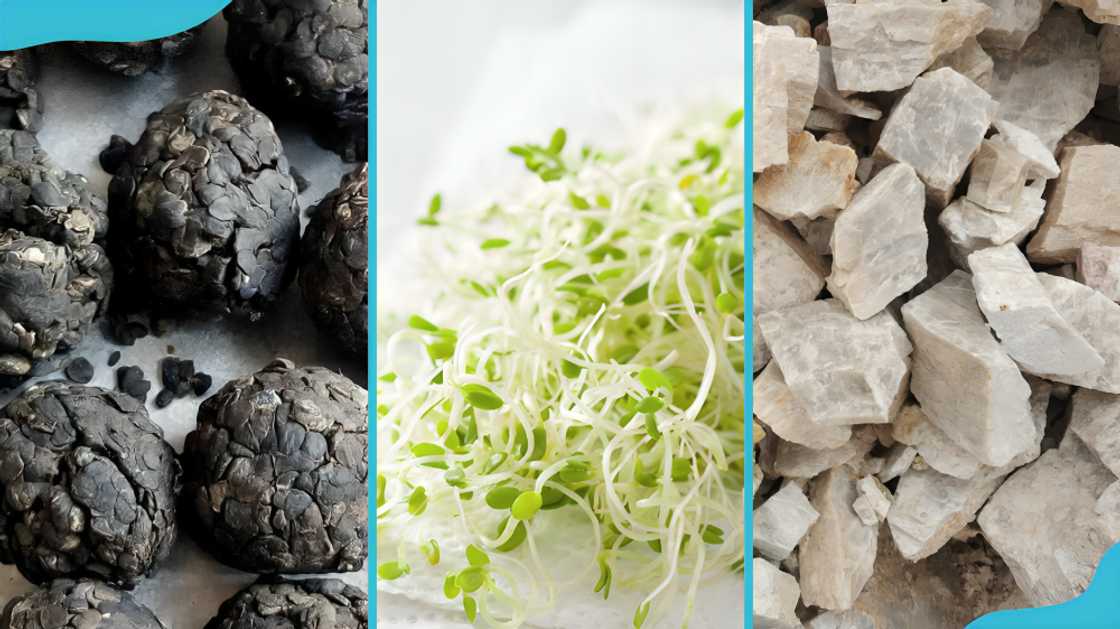
Source: UGC
TABLE OF CONTENTS
- What are the most commonly used spices in Ghana?
- 1. Cloves (dadoa amba or peppre)
- 2. Anise seeds (nketenkete/nkitinkiti)
- 3. Basil (nunum/akokobessa/akokomɛsa)
- 4. Senegal pepper (hwentia or ahentia)
- 5. West African black pepper (esoro wisa)
- 6. African bird pepper (misewain)
- 7. Guinea pepper (efom wisa)
- 8. African nutmeg (wedie abain or awerewain)
- 9. Turkey berries (abeduruin or kwahu nsosuain)
- 10. African locust beans (dawadawa)
- 11. Prekese (aidan)
- 12. Elephant ear leaves (nkontomire leaves)
- 13. Limestone (kaun - potash)
- 14. Miracle fruit plant leaves (waakye leaves)
- 15. Unripe pawpaw (papaya)
- 16. Star anise (nketenkete/nkitinkiti)
- 17. Wild marjoram (oregano)
- 18. Cumin seeds (nketenkete/nkitinkiti)
- 19. Winter cherry (ashwagandha)
- 20. Lucerne sprouts (alfalfa)
- 21. Boswellia resin (Boswellia)
- 22. Cayenne pepper (misewain)
- 23. Cinnamon bark (nyamedua)
- 24. Ginseng root (insam-twi)
- 25. Turmeric root (curcuma longa)
- 26. Cardamon (Cardamon)
- 27. Coriander seeds (Coriander)
- 28. Curry leaves/powder (curry leaves or powder)
- 29. Ginger (kakadro)
- 30. Paprika (kpaposhitɔ)
- 31. Mace (mace)
- 32. Garlic (galeke)
- 33. Jute mallow (ayoyo)
- 34. Justicia flava (afema)
- 35. Scotch bonnet pepper (kpakposhito)
- What are the spices for fried rice in Ghana?
- What are the spices of Jollof rice?
- What are the spices of shito?
- What are the spices of egusi?
- What are the spices for stew in Ghana?
This article lists spices that you can easily find in Ghanaian local markets in rural and urban places. Some are very affordable, while others are pretty expensive. Additionally, the spices are preserved through smoking, drying, freezing, salting, and roasting.
What are the most commonly used spices in Ghana?
The health benefits of Ghana spices make them essential ingredients. Knowing these spices and their uses can impact how you prepare your meals. This article discusses the following local spices in Ghana and more:
Rank | Spice's English name | Spice's Twi name |
1. | Cloves | Dadoa amba/peppre |
2. | Anise seeds | Nketenkete/nkitinkiti |
3. | Basil | Nunum/akokobessa/akokomɛsa |
4. | Senegal pepper | Hwentia/ahentia |
5. | West African black pepper | Esoro wisa |
6. | African bird pepper | Misewain |
7. | Guinea pepper | Efom wisa |
8. | African nutmeg | Wedie abain/awerewain |
9. | Turkey berries | Abeduruin/kwahu nsosuain |
10. | African locust beans | Dawadawa |
11. | Prekese | Aidan |
12. | Elephant ear leaves | Nkontomire |
13. | Limestone | Kaun - potash |
14. | Miracle fruit plant leaves | Waakye leaves |
15. | Unripe pawpaw | Papaya |
Knowing popular spices in Ghana and their names in English and Twi could make finding them easier at your nearest store. Some spices are household staples in the country, while others are used sparingly at home and in hotels. Discover below Twi Ghanaian local names of spices in Ghana:
1. Cloves (dadoa amba or peppre)

Source: UGC
Cloves are among Ghana's most commonly used spices. They are referred to as dadoa amba or peppre in Twi and mbrego amba in Fante.
The aromatic spice has a sweet flavor and is often used as a baking, Jollof rice, and groundnut soup ingredient. You can also use the spice to season roasts and flavor hot beverages.
The herb has many health benefits, including anti-inflammatory properties, blood sugar regulation, better oral health, and improved liver health.
2. Anise seeds (nketenkete/nkitinkiti)
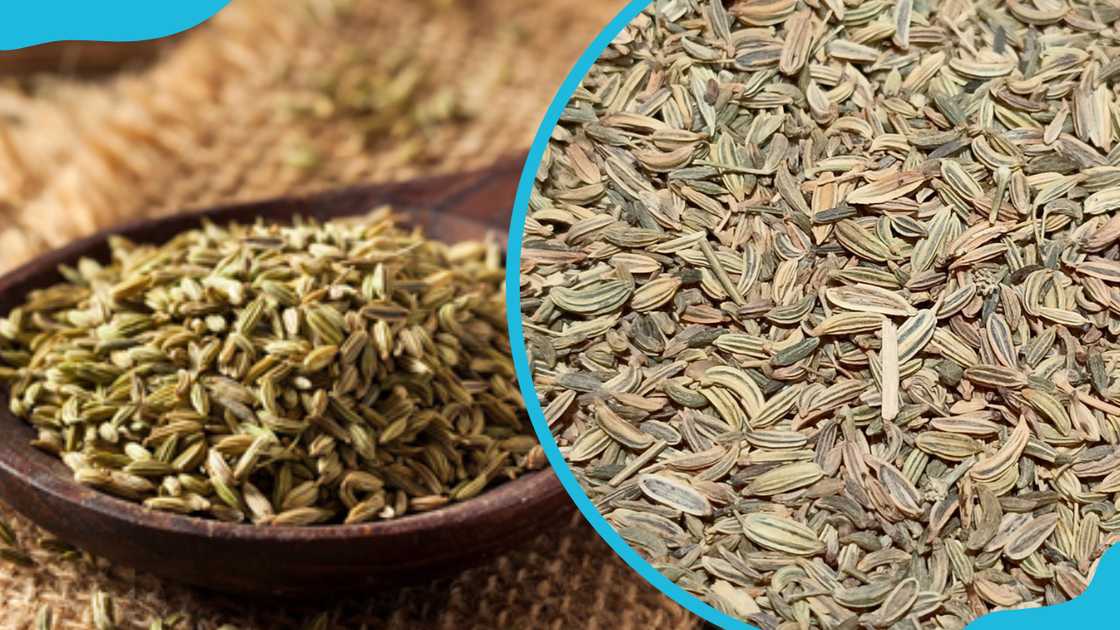
Source: UGC
Known as osu kon in Ga and nketenkete/nkitinkiti in Twi, Anise seeds are one of the most popular spices in Ghana. They have a distinct, sweet, licorice-like taste and are often used to flavor desserts, drinks, seafood, meat, fruit, and chocolate.
The spice blends well with spices and herbs like caraway, clove, mace, pink pepper berries, and tarragon. Consumption of Anise seeds helps improve digestion, reduce nausea, and alleviate cramps.
In addition, the seeds contain thymol, terpineol, and anethole, which are good at relieving coughs. They can also ease bloating, constipation, and stomach gas when taken in tea after meals.
3. Basil (nunum/akokobessa/akokomɛsa)

Source: UGC
West African basil, also called emaleko (Nzema), nunum (Twi), adefetue (Ewe), or daidoya (Hausa), is another herb used almost everywhere in Ghana. It is known as and is commonly used in tea, poultry stews, pasta dishes, vegetables, and other dishes.
Sweet basil leaves (akokobessa/akokomɛsa) have a subtle peppery flavor and a hint of mint, while the other varieties have a spicy citrus taste. The herb is an antidepressant for reducing stress, depression, and anxiety.
4. Senegal pepper (hwentia or ahentia)
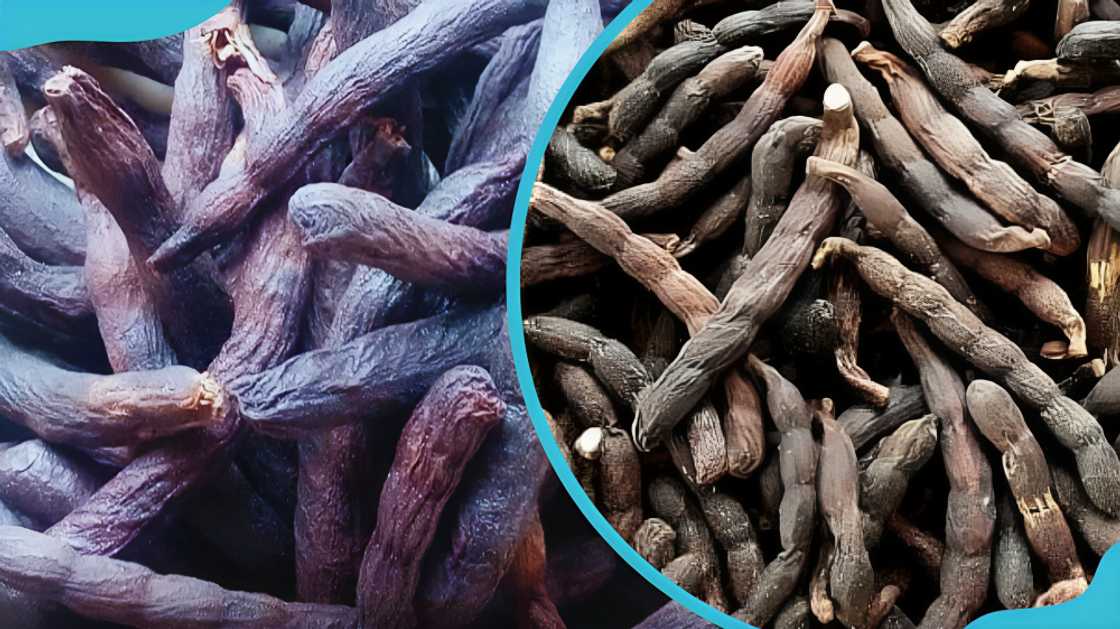
Source: UGC
This aromatic spice is common in Ghana, Nigeria, Senegal, Brazil, and Ethiopia. It is called hwentia or ahentia in Twi and soh in Ga. Igbo and Yorubas of Nigeria call it uda and eeru alamo, respectively. Other people know it as the Ethiopian/Moor/Negro pepper or the Grains of Selim.
When used sparingly, the pepper gives a nutmeg-like taste and a bitter taste when taken in excess. Ghanaians use it in soups, stews, sauces, and drinks. The pods are also smoked, crushed, and used as a meat or fish rub. The spice is excellent for Shito, a smoked crayfish hot pepper sauce that is a staple in many Ghanaian homes.

Read also
Le Petit Samaritain: 23-year-old Ghanaian lady establishes exquisite restaurant in Paris, videos drop
The spice has medicinal benefits due to its microbial properties. It is a remedy for dermatological problems, relieves gastrointestinal issues, and has anti-inflammatory properties.
5. West African black pepper (esoro wisa)
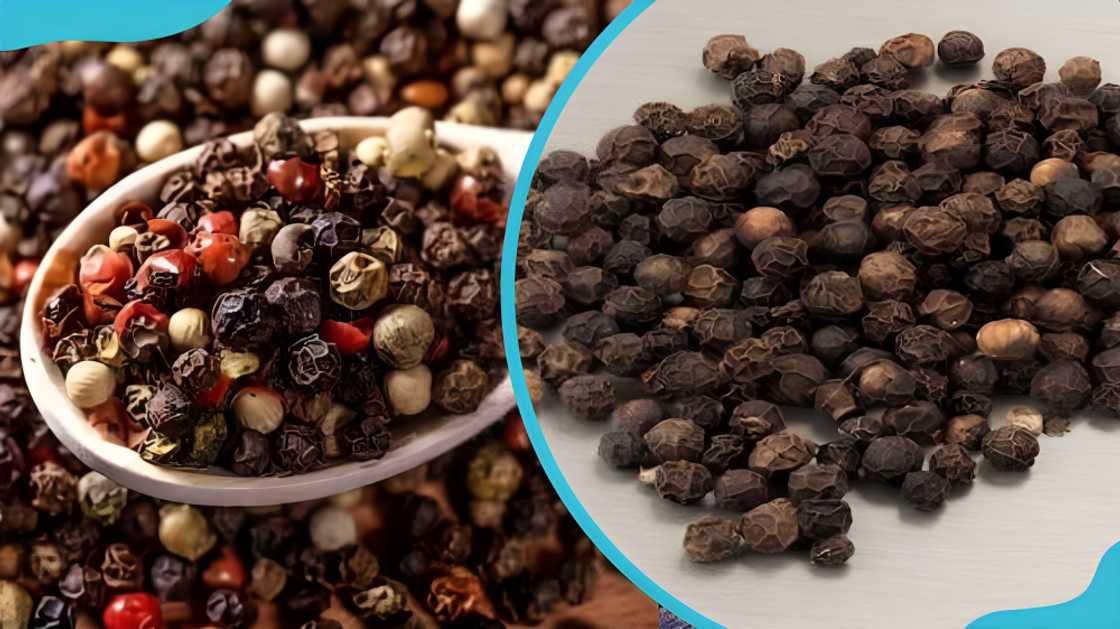
Source: UGC
The West African black pepper is known as esoro wisa in Twi and wie din in Ga. The pepper is not as hot as the African bird pepper and other pepper species. Interestingly, one can eat the leaves, too.
Esoro Wisa has a clove-like flavor and is used in minimal quantities in chicken, meat, and fish soups/stews, chewing gum, and cornmeal porridge (hausa koko).
The West African black pepper increases appetite while reducing constipation and indigestion. It also helps lose weight and consists of potassium that helps regulate heart rate and high blood pressure.
6. African bird pepper (misewain)
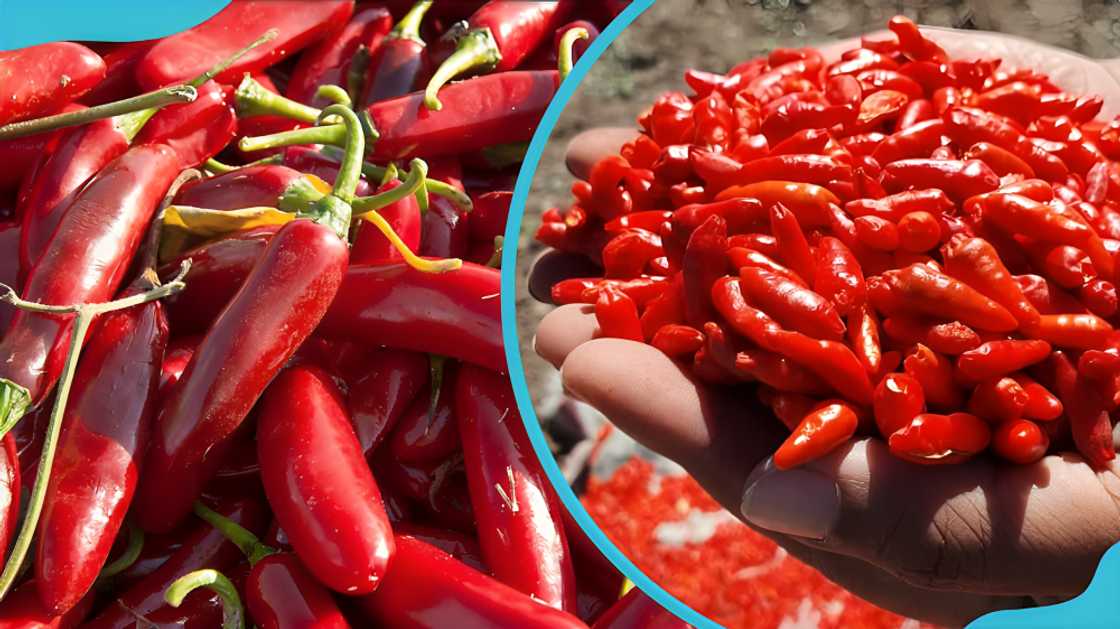
Source: UGC
African bird pepper is known as akweley waabiin in Ga and misewain in Twi. Its other names are piri-piri, malagueta pepper, African devil, goat's pepper, and cockspur pepper.
The chilli is very hot and suits spicy meals. Ghanaians use it to season grilled, roasted, and stewed meat dishes like beef, fish, and poultry. It is also great for vegetarian dishes like bean and vegetable stews, tomato and onion salads, and snacks like rissole.
Medicinally, African bird pepper treats enemas, arthritis, and psoriasis. It reduces blood pressure, helps digestion of foods by stimulating peristalsis, breaks up phlegm, and eases stomach upsets.
7. Guinea pepper (efom wisa)
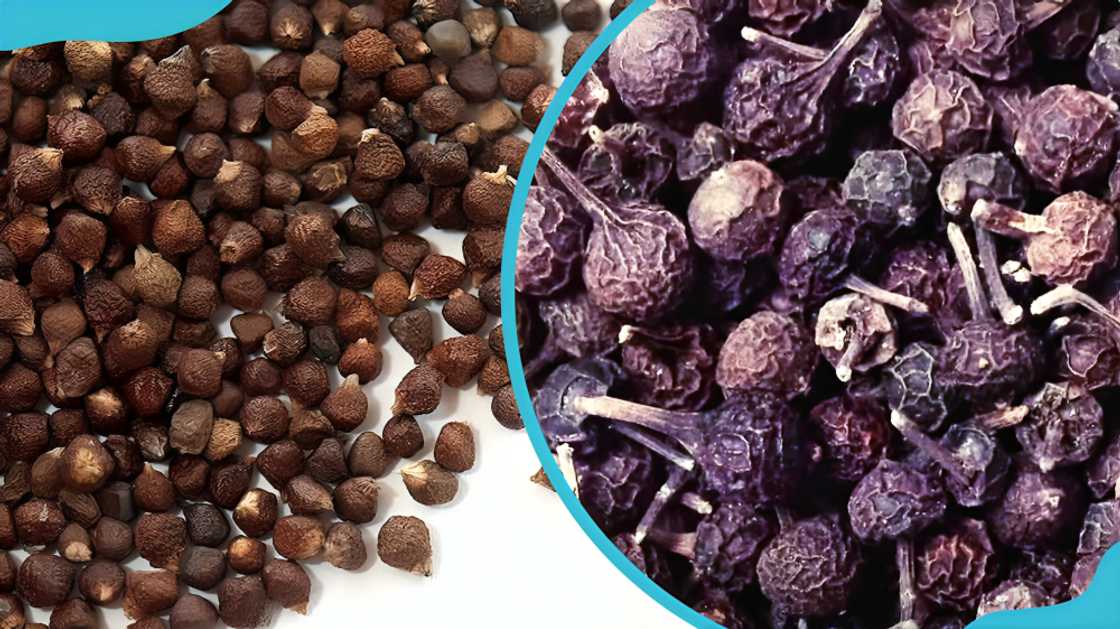
Source: UGC
The spice is called the Grains of Paradise, alligator, Ashanti, and Melegueta pepper. It is known as efom wisain or efom wisa in Twi, wire tsuruin in Ga, and essa in Nzema.
Efom wisa is one of the most expensive natural spices in Ghana. It has a savory flavor and makes stews like okro and shito. The spice can also season meat, chicken, pork, baked food, and traditionally brewed beer.
Many use the Guinea pepper as a remedy for snakebites, stomach disorders, diarrhea, heart disease, obesity, etc. However, no good scientific evidence proves it cures these ailments.
8. African nutmeg (wedie abain or awerewain)
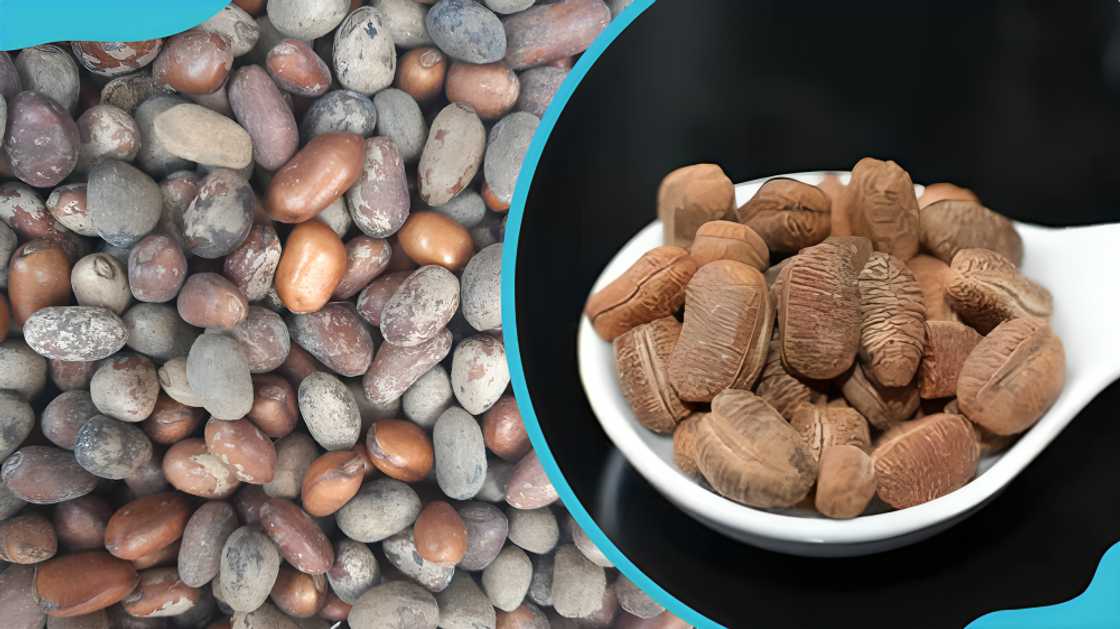
Source: UGC
The African nutmeg is also known as wedie abain or awerewain in Twi. In Nigeria, the Yorubas call it ariwo, Hausa's call it gujiya dan miya, the Igbos call it ehuru, and the Urbobos call it ehre.
Other names for the African nutmeg are calabash nutmeg, the African orchid nutmeg, Ghana seeds, and Jamaican nutmeg. The spice has a warm and nutty taste with a deeper woodiness. Its aromatic fragrance makes it suitable for spicing assorted foods like vegetables, confections, sausages, sauces, meats, puddings, etc.
The nutmeg is sometimes roasted to intensify its flavor. It is believed that it boosts sex drive in humans and can help alleviate problems associated with sickle cell anemia.
9. Turkey berries (abeduruin or kwahu nsosuain)

Source: UGC
Turkey berries, wild eggplant, or prickly nightshade are known as abeduruin or kwahu nsosuain in Twi. Their other local Ghanian names are kwanwu nsosuaa, kantɔsi, and abeduru.
Ghanaians use these berries to add bitterness to peanut sauce, egg stew, Turkey berry/susumba curry, light chicken soup, and other relishes.
The berries have many health benefits, including preventing cardiovascular diseases and strokes, treating phlegm and excessive mucus, treating indigestion and diarrhea, preventing intestinal works, regulating menstruation, etc.
10. African locust beans (dawadawa)
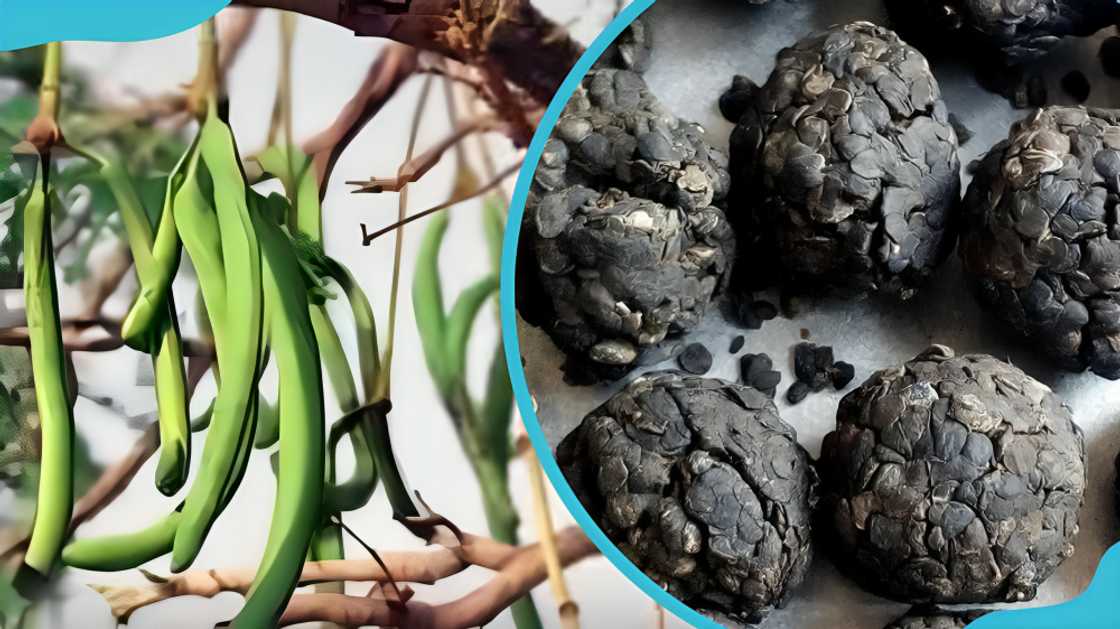
Source: UGC
African locust bean is known as dawadawa in Twi. The seeds are fermented and made into aromatic cakes. They have a fowl smell but add a distinct aroma and sweet, sour flavor in Jollof rice and soups like okra, ogbono, edikaikong, etinkeni mmong ikong (waterleaf and uziza), baobab (miyar kuka), egusi, and vegetable soup.
To make dawadawa, cook the seeds to remove the seed coat. Dry and pound them for several minutes, then dry them in the sun again. Boil the seeds again for two hours, drain the stew, and place the seeds in a fabric bag. Leave the seeds in the bags for 72 hours until they fully ferment.
The fermented locust bean seeds are used in controlling diabetes and cholesterol levels. Additionally, they promote good sight, aid digestion, reduce blood sugar levels, and are used for treating stroke, hypertension, and bacterial infections.
11. Prekese (aidan)
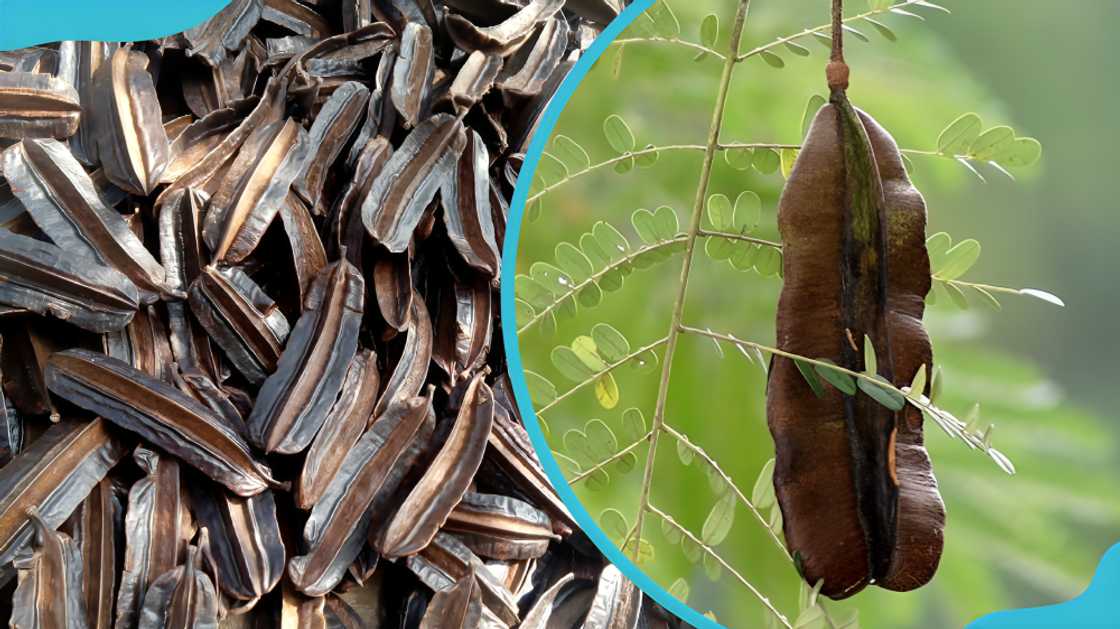
Source: UGC
When burnt in a coal pot-like incense, the spice gives off a sweet aroma. Besides adding to traditional soups, aidan/prekese is excellent for baking and making desserts. Ibo call it oshosho or osakirisa, while Yoruba and Twi call it aidan.
Prekese pods can be dried for year-round use, chopped or crushed, and used in tinctures, drinks, or food. Meanwhile, the plant can make skin-soothing soaps and balms, palm kernel oil or shea butter for dermatological care, perfumes, and natural mosquito repellants.
Some say that aidan had several medicinal powers. For instance, sources claim it increases milk in lactating mothers, increases blood flow, eliminates blood clots, and possesses anti-inflammatory properties.
12. Elephant ear leaves (nkontomire leaves)

Source: UGC
Nkontomire leaves are added to dried or smoked fish, prawns, or crayfish to make a savory stew. They can also be used in a bean stew called Aboboi.
Kontomire or taro leaves should be soaked in clean water and then boiled for 10-15 minutes to remove toxic substances before being added to any stew.
Besides being used as food, the leaves of the taro plant (Songe) make excellent decorative plants for living rooms. They can be as large as three feet long and two feet wide.
13. Limestone (kaun - potash)
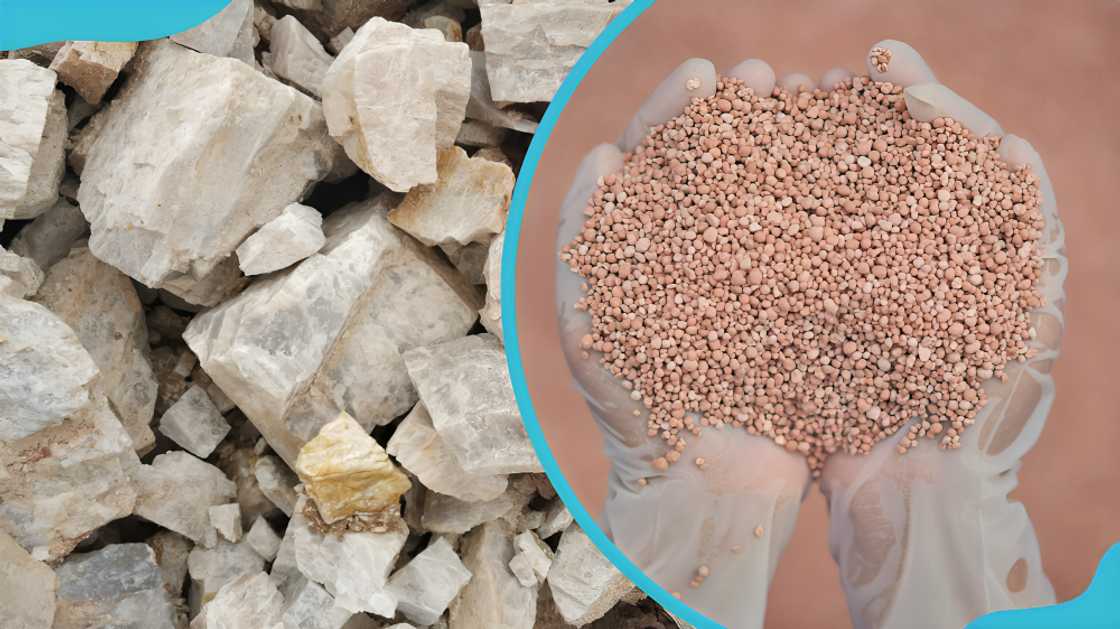
Source: UGC
Kaawe/kanwu/kaun (potash) prepares Okra soup and Waakye, a mush of rice with beans. The local spice is grounded and used as a salt substitute, food thickener, and tenderizer. You can also use the powder to increase the PH of the wine.
Ground akanwu is mixed with water and applied to the tooth to relieve toothache, act as a preservative, and be used for cleaning and preventing molds and mildew.

Read also
Tracey Boakye and her family go viral as they rock classy outfits during their vacation in Amsterdam
14. Miracle fruit plant leaves (waakye leaves)

Source: UGC
Waakye/katemfe/uma/moi moi leaves are used in Nigeria, Ghana, and other parts of West Africa to wrap or package food. These leaves retain moisture and heat in food. The dish also absorbs nutritional properties from the leaves.
Moi Moi leaves are indigenous to the rain forests of West Africa but have also been introduced to Australia and Singapore. The plant is traditionally used to sweeten fermented foods and palm wine in West Africa. Its sweetness is okay for diabetics diet.
15. Unripe pawpaw (papaya)

Source: UGC
Unripe pawpaw is diced and added to meat to tenderize it. It produces a white milky juice (latex) containing papain enzymes, which softens meat. You can also marinate the meat with the pulp before cooking.
Some people add unripe papaya to salads because it is odorless and tastes bitter. You can also use it as a vegetable when making pies, sherbets, and sweets.
Nonetheless, people are careful when using raw pawpaws because enzyme papain can cause pregnancy problems. The components might be harmful to babies.

Read also
Throwback pic of the stunning Kente dress and charming hairstyle Serwaa Amihere wore to Henry Fritz's wedding
16. Star anise (nketenkete/nkitinkiti)
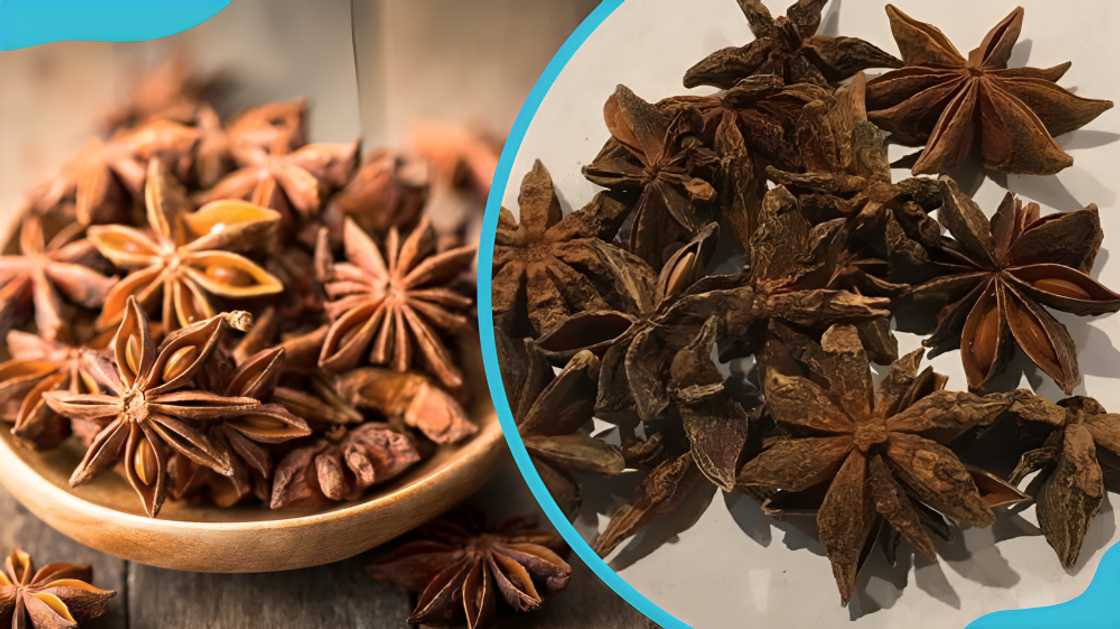
Source: UGC
Star anise seeds are aptly named for the star-shaped pods from which they are harvested. They seeds a flavor that is reminiscent of licorice. They are often confused with anise because of similarities in their flavor and names.
Anise seed and star anise come from different plants. Nonetheless, they have similar flavor profiles because they share the essential oil anethole. However, star anise is considered more bitter and herbaceous.
Star anise seeds are used in Ghanaian foods and beverages. The spice makes an important ingredient for stews and meat/fish seasoning. Spiced rice can be toasted lightly with coconut oil and cooked with toasted star anise and cumin seeds.
17. Wild marjoram (oregano)
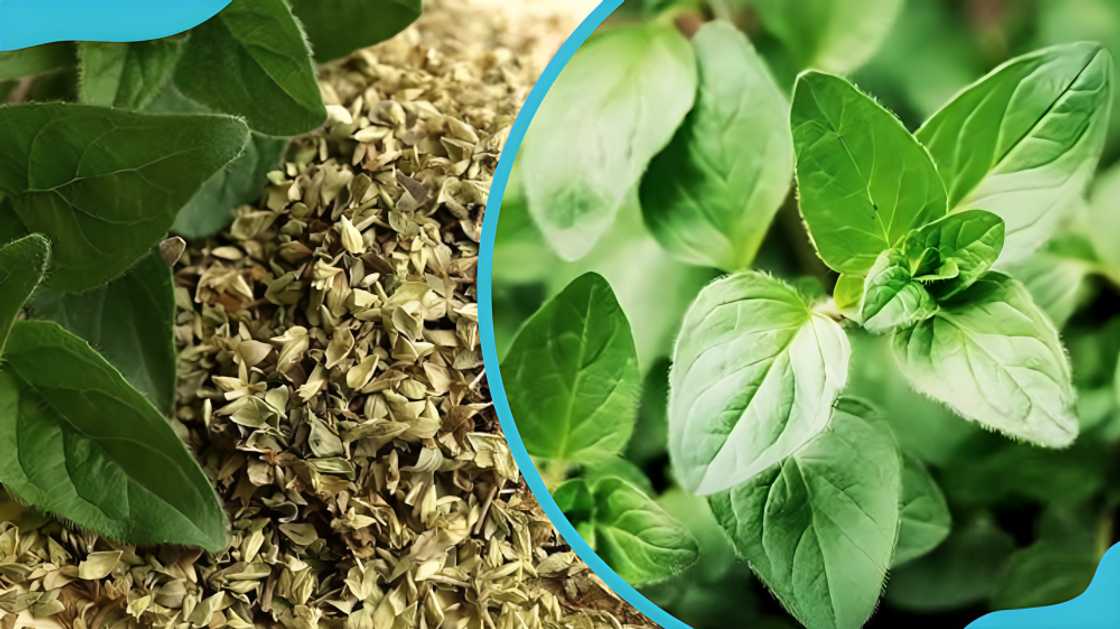
Source: UGC
Clean and dressed tilapia/chopped pork/poultry/meat is usually seasoned and stuffed with dried and crushed oregano.
Mix the spice with black pepper powder, thyme, paprika, salt, cumin, garlic, cayenne pepper, ginger powder, onion, and chili powder.

Read also
Heavily endowed Snapchat influencer goes viral with her classy kente gown for her luxurious wedding ceremony
Oregano is a member of the mint family Lamiaceae. The spice has a strong flavor, warmth to dishes, and a hint of subtle sweetness.
18. Cumin seeds (nketenkete/nkitinkiti)
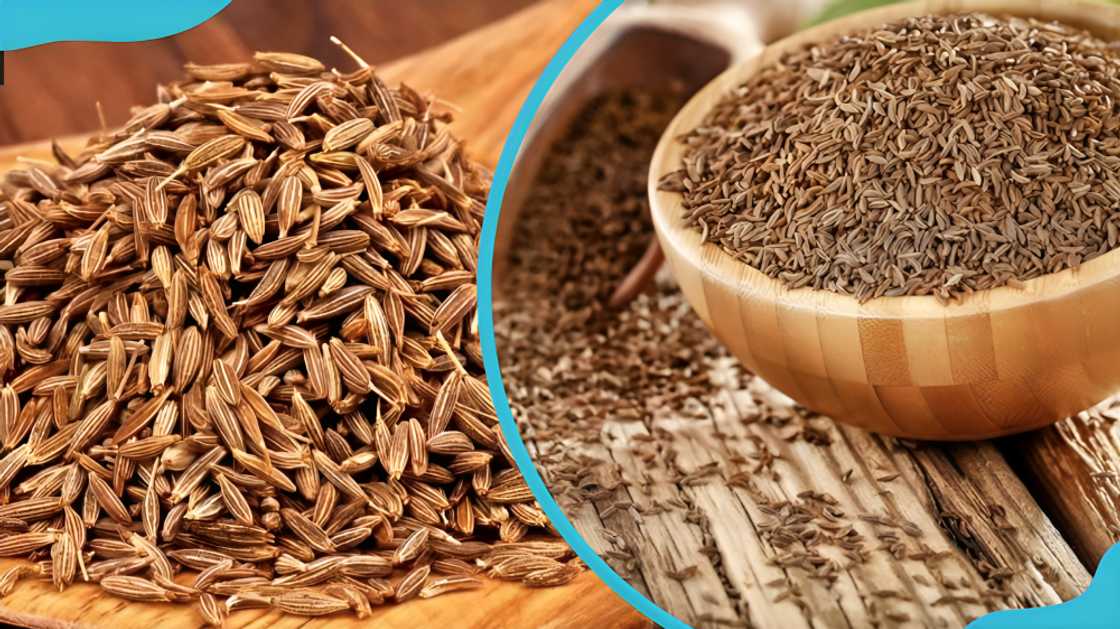
Source: UGC
Cumin seeds are a typical ingredient in many spice blends. They add instant depth to any dish due to its warm flavors with a hint of citrus. The spice is native to Asia, Africa, and Europe and is famous for its many health benefits.
These seeds work well in various rice dishes, vegetable and meat stews and dishes, bean stews, breads, pickles, and barbecue sauces.
Like Anise seeds, Cumin seeds in Twi are also known as nketenkete/nkitinkiti. However, the two have very different tastes. Anise is fresh with a distinctive aroma that resembles licorice, whereas cumin is on the earthy side of the palette.
19. Winter cherry (ashwagandha)

Source: UGC
Its common names are Indian ginseng, Winter cherry, and Ajagandha. It is commonly used as a stress reliever and an immune system booster.
Ashwagandha roots, leaves, and seeds taste bitter and are commonly used for curries. They also flavor soups, stews, and other savory dishes.

Read also
Makola women glow they slay in beautiful outfits and makeup while gracing the cover of Glitz Magazine
The seeds possess a diuretic effect, while the leaves have sedative, anti-inflammatory, and analgesic properties. In Ghana, the roots are known for their anti-inflammatory, anti-microbial, soothing, immune-boosting, and analgesic properties.
20. Lucerne sprouts (alfalfa)
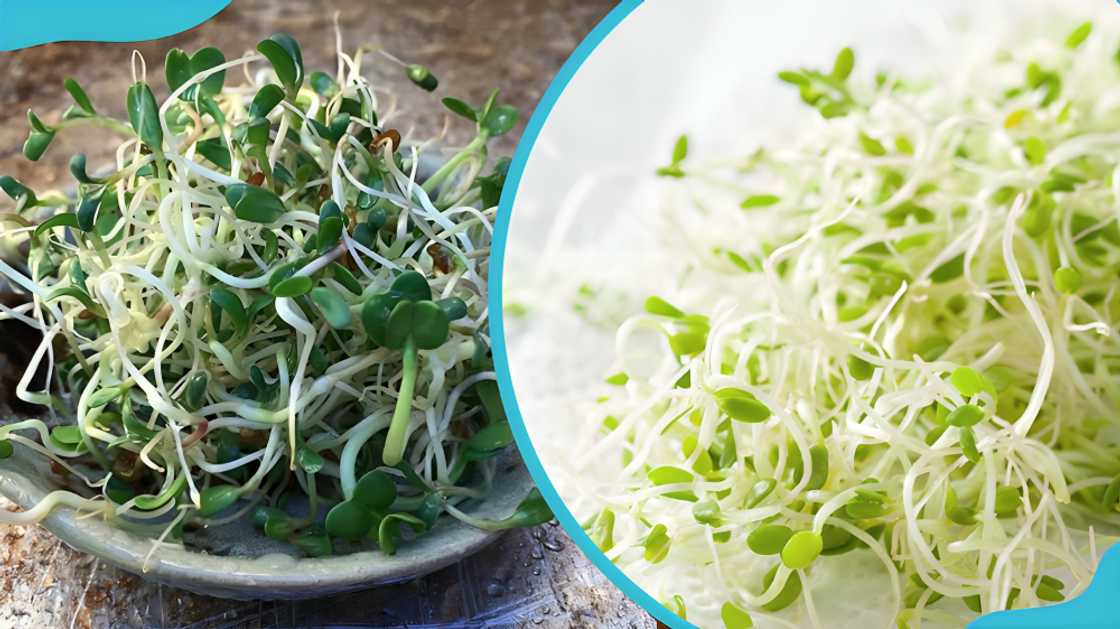
Source: UGC
Alfalfa's stem, leaves, and sprouts are rich in vitamins, minerals, and proteins. The herb is also called Buffalo grass, Lucerne, or Chilean clover.
The sprouts taste slightly nutty and are a delicious addition to sandwiches, salads, toasts, and soups. Also, alfalfa sprouts are best consumed fresh (instead of cooked) because their raw texture is ultra crisp and delightfully vegetal.
The alfalfa sprouts are suitable for treating arthritis and digestive problems. They can also be used as a diuretic and can reduce high cholesterol. They have a high concentration of beta-carotene, which builds the immune system, and the herb's chlorophyll is suitable for people with body odor and bad breath.
21. Boswellia resin (Boswellia)

Source: UGC
Boswellia, also known as Indian frankincense, is an extract from the Boswellia serrata tree. Boswellia resin oil and extracts are used in soaps, cosmetics, foods, and beverages. It can season various dishes, including vegetable stir-fries, rice, and meat.
The herb, which has a pleasant aroma, is a remedy for diabetes, rheumatism, asthma, cardiovascular disorders, and fevers. It is also an effective anti-inflammatory and can be used to ease joint pains.
22. Cayenne pepper (misewain)
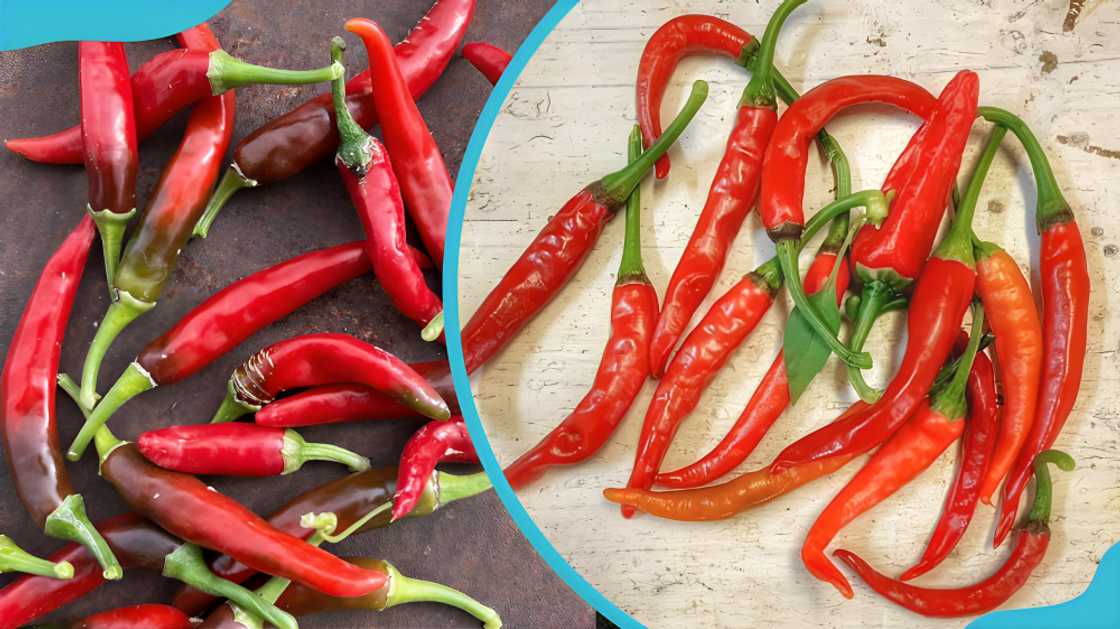
Source: UGC
Also called red pepper, capsicum, and chili pepper, sweet and spicy cayenne works well when paired with sweet foods like pineapples, sweet potatoes, and chocolates. Meanwhile, the hot cayenne peppers suit soups, egg dishes, curries, and many other sauces.
Cayenne pepper is used to relieve pain and combat infections. It is also suitable for toothaches and arthritis and aids digestion. Also, its antibacterial properties stimulate blood flow and are rich in minerals, vitamins, and antioxidants, which help maintain cardiovascular health.
23. Cinnamon bark (nyamedua)
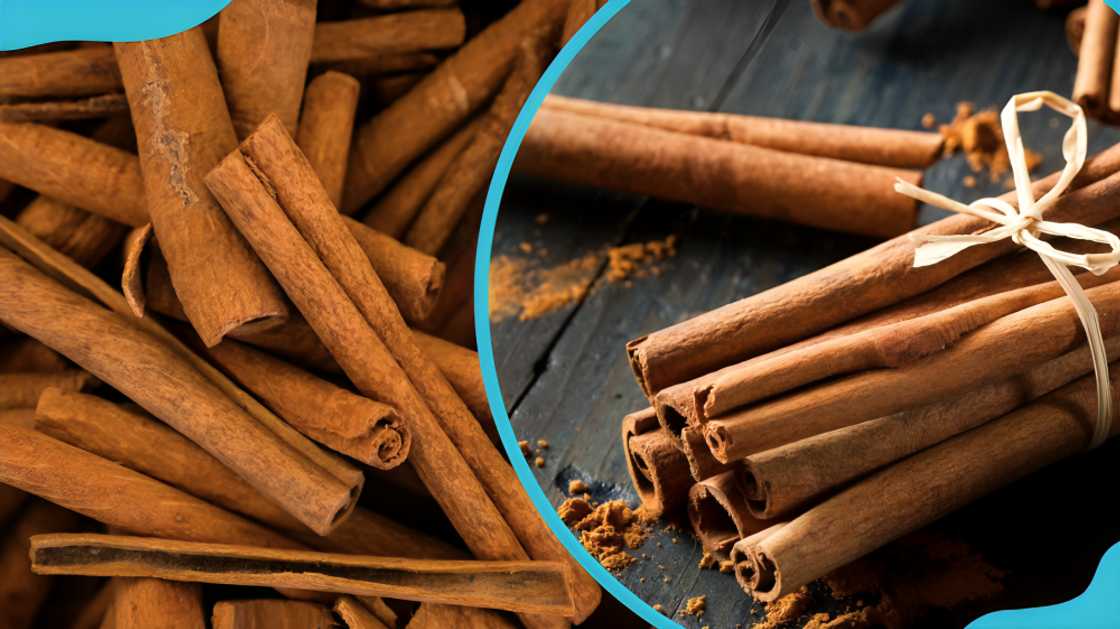
Source: UGC
Cinnamon aids digestion and treats nausea, colds, and inflammation. In addition, the bark has essential oils that possess anti-fungal and antibacterial properties.
Cinnamon has a sweet and woody flavor with a slight citrusy note. It is used to prepare savory yams, chicken, and lamb dishes, drinks like tea, cocoa, and chocolate, and desserts like cakes, cookies, and pies.
24. Ginseng root (insam-twi)
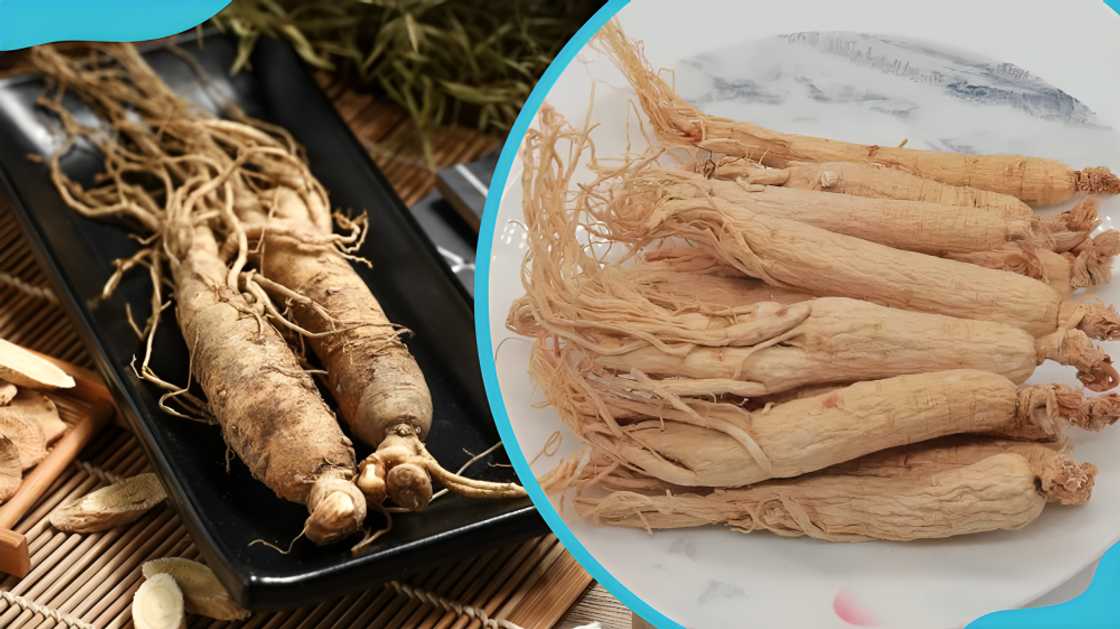
Source: UGC
Ginseng can be added to soups, beverages, and stir-fried dishes. Mix its powder with pineapples, mangos, and peaches when making smoothies, or stir the ginseng powder in oatmeal.
Ginseng roots can help a person handle mental and physical stress better. The bitter herb is good for warding off fatigue, sharpening mental abilities, and energizing the body.
In addition, the ginseng roots are immune system boosters. Nonetheless, these herbs are unsuitable for high blood pressure patients, and prolonged usage causes irritability.
25. Turmeric root (curcuma longa)

Source: UGC
Turmeric, also called nkabe ase or ateagyaa ase in Akan and curcuma longa in Twi, has graced countless cultures worldwide with its gorgeous coloring, unique aroma, and unmistakable flavor. You can use the herb in its natural state as a root or in powdered pressed extract.
The spice provides countless preventative and healing measures. It contains a chemical substance called curcumin, a natural liver detoxifier, and also has substances that can potentially prevent cancer, heart disease, Alzheimer's disease, depression, and arthritis.

Read also
Nana Ama McBrown stuns in glittering long-sleeve kente gown while jamming to King Paluta's Aseda song
Turmeric is overwhelmingly earthy and bitter, with a bit of pepper spice. Half a teaspoon of ground turmeric is plenty for seasoning bean dishes, rice dishes, whole grains, soups, stews, sauces, marinades, and pickling brines.
26. Cardamon (Cardamon)
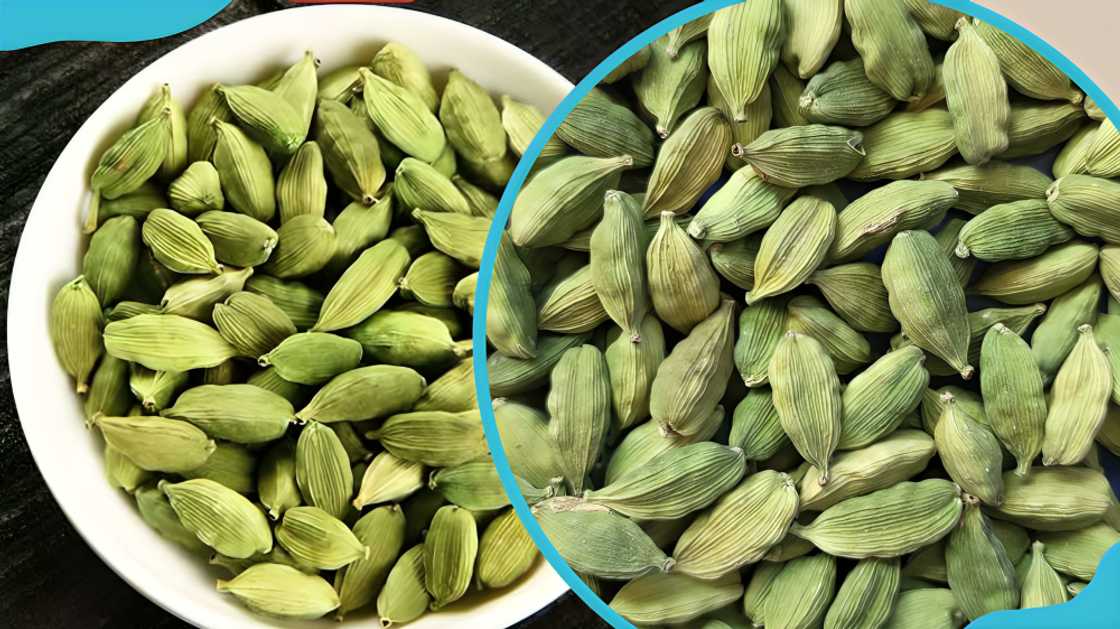
Source: UGC
Cardamom originated from India and is known for its intense flavor. Dishes for cardamom seasoning include curry dishes, rice pudding, tea, and baked goods such as cookies, bread pudding, and cheesecake.
The spice blends with garam masala, cinnamon, cloves, and nutmeg. Cardamom is used for traditional medicine applications like the control of asthma, teeth, gum infections, cataracts, nausea, diarrhea, and cardiac, digestive, and kidney disorders.
27. Coriander seeds (Coriander)

Source: UGC
Coriander seeds come from the plant cilantro, a popular herb. The fragrant spice, full of antioxidants, is used for its many culinary and health benefits. The seeds have a pleasing, lemony flavor and aroma.
Use coriander seeds in eggs, vegetables, shrimp, beef, chicken, ham, lentils, pork, and potatoes. Also, fruits like mango, orange, papaya, pineapple, melon, and strawberry taste better with this spice.
28. Curry leaves/powder (curry leaves or powder)

Source: UGC
Curry leaves are blended with spices and herbs to make a spicy powder. The powder mainly comprises bold flavors like chili peppers, turmeric, cumin, cardamom, ginger, and curry leaves.

Read also
Berla Mundi wants to break the internet with her elegant African print suit on her 36th birthday
The spice is commonly used to flavor soups, stews, and vegetables. Due to its ingredients, it tastes sweet and savory. Consuming curry powder may boost brain and digestive health, improve feelings of fullness, lower blood sugar levels, and provide antibacterial
29. Ginger (kakadro)
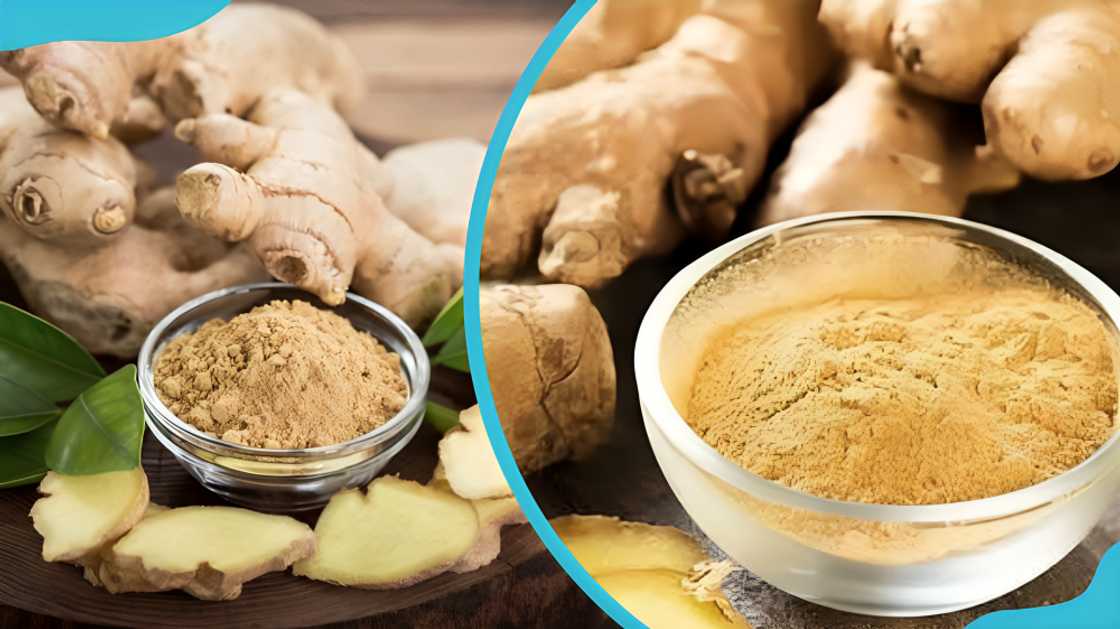
Source: UGC
Ginger remains a popular spice used as a remedy for nausea and other health issues. Its benefits in the kitchen and for human health make it one of the best Ghanaian spices to stock up on.
Ginger has a slightly peppery and sweet taste. The spice adds a kick to stews, curries, stir-fries, cocktails, and salad dressings.
30. Paprika (kpaposhitɔ)
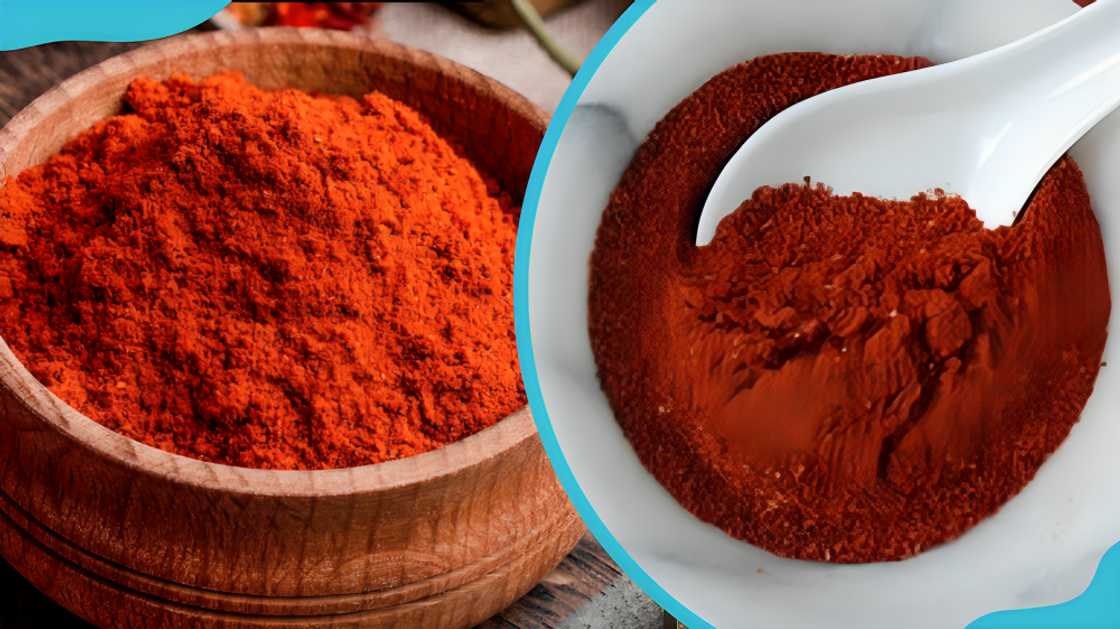
Source: UGC
Made from dried and ground red bell peppers, paprika remains a game changer in the kitchen. The spice has a sweet and peppery taste and can bring any dish to life.
Different capsicums are used to create sweet, hot, or smoked paprika. If you're wondering how to use paprika, try it on any pork, chicken, or beef stew. The spice also brings a beautiful color and a hint of sweetness to barbecue, sausages, potato casseroles, cream sauces, and egg dishes.
31. Mace (mace)

Source: UGC
Mace is a yellowish-brown spice from the dried lacy coating of the nutmeg seed. It is mainly used in baked goods due to its sweet and savory flavor.
The spice is also great for flavoring meat and fish dishes, pastries, casseroles, stews, pumpkin or sweet potato pie, donuts, and barbeque blends.
32. Garlic (galeke)

Source: UGC
Garlic is a spice often added to dishes in small amounts to heighten the flavors. It is widely used as a flavoring in any vegetable, potato, salad, pasta, dip, meat, or fish dishes. When eaten raw, garlic has a pungent taste and odor. However, the heat gives the garlic a sweet, buttery flavor if used for cooking.
33. Jute mallow (ayoyo)
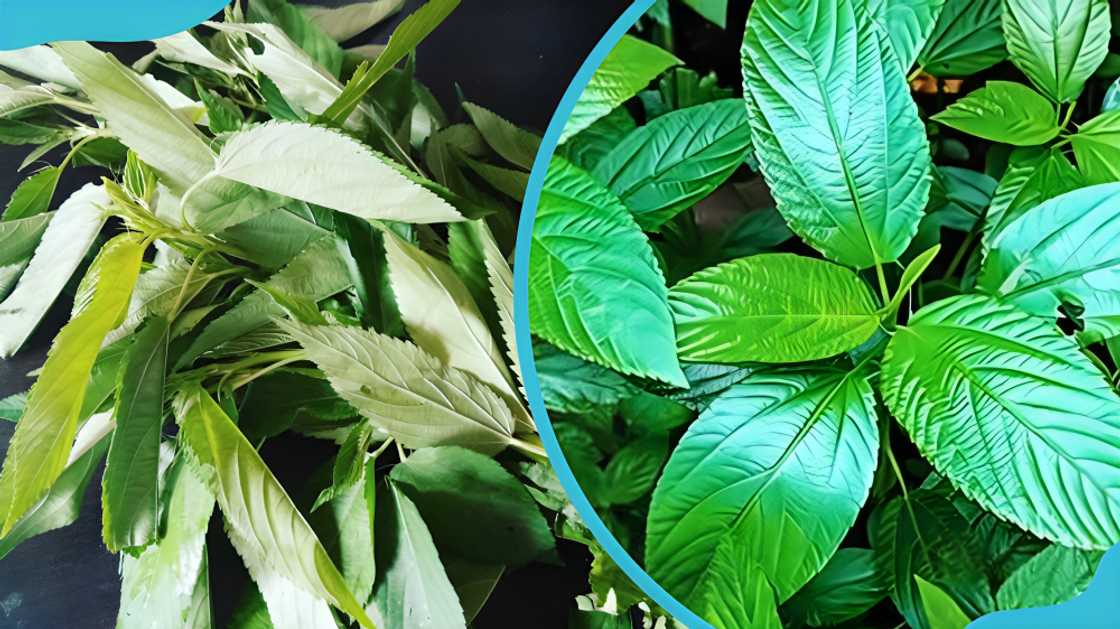
Source: UGC
Jute mallow (ayoyo) is used in traditional tuo zaafi, a dish popular in northern Ghana. Nigerians have a similar dish called amala.
The traditional preparation of ayoyo is usually with water, dried fish, and dawadawa. Ayoyo leaves taste bitter, though their taste may vary based on age. Young leaves are tender and flavorful, while older ones are earthier and more fibrous.
34. Justicia flava (afema)
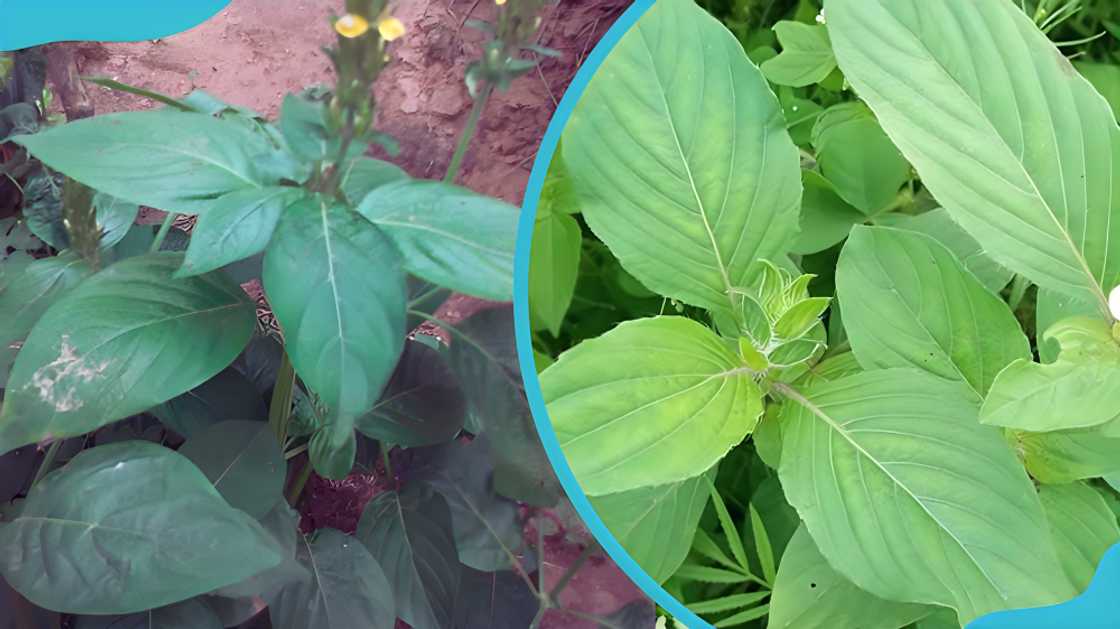
Source: UGC
Justicia flava is called afema in the Asante-Twi language in Ghana. It is used in traditional medicine to treat cough, epilepsy, convulsion, paralysis, fever, spasm, and skin infections. You can add the herb to soups or stews or serve with roasted meat/vegetables.

Read also
Osebo gets posted by international platform, gets Nigerians & other countries teasing Ghanaians
35. Scotch bonnet pepper (kpakposhito)

Source: UGC
Scotch bonnet/Bonney/Caribbean red peppers are called kpakposhito in the Twi language. They add heat and flavor to marinades, sauces, dips, soups, stews, and grilled meats.
What are the spices for fried rice in Ghana?
You need curry powder, onions, garlic powder, green pepper, onions, carrot, bell pepper, and broccoli stems to prepare a flavorful but simple Ghanaian fried rice dish.
What are the spices of Jollof rice?
Tomato puree, curry, garlic, ginger powders, pepper sauce, onions, paprika, and cumin are the basic spices when cooking Ghanaian Jollof rice. You can add any other dried herbs and crushed bouillon cubes.
What are the spices of shito?
The Ghanaian shito sauce primarily consists of fish or vegetable oil, ginger, dried fish, prawns, crustaceans, tomatoes, garlic, and peppers.
What are the spices of egusi?
You need onions, chillis/peppers, garlic, paprika, and tomato paste to season your egusi soup.
What are the spices for stew in Ghana?
Salt, paprika, rosemary, black pepper, and cumin are Ghana's most common spices for stews. Common Ghanaian soups are groundnut, light (tomato), palm nut, ayoyo, garden eggs, egusi (pumpkin seeds), spinach, okra, kontomire (taro leaves) sauces.
What is Nkitinkiti in English?
Nketenkete/nkitinkiti are Twi words for anise and star anise seeds. Some Ghanaians also call cumin seeds by these Twi names.
What is the English name for Esoro wisa?
Esoro wisa is a Twi name for the West African black pepper spice. Twi is a variety of the Akan language spoken in southern and central Ghana.
Spices in Ghana improve food taste and are a good source of vitamins, iron, calcium, and other antioxidants. So, adding a few can elevate the whole meal and make it taste better.
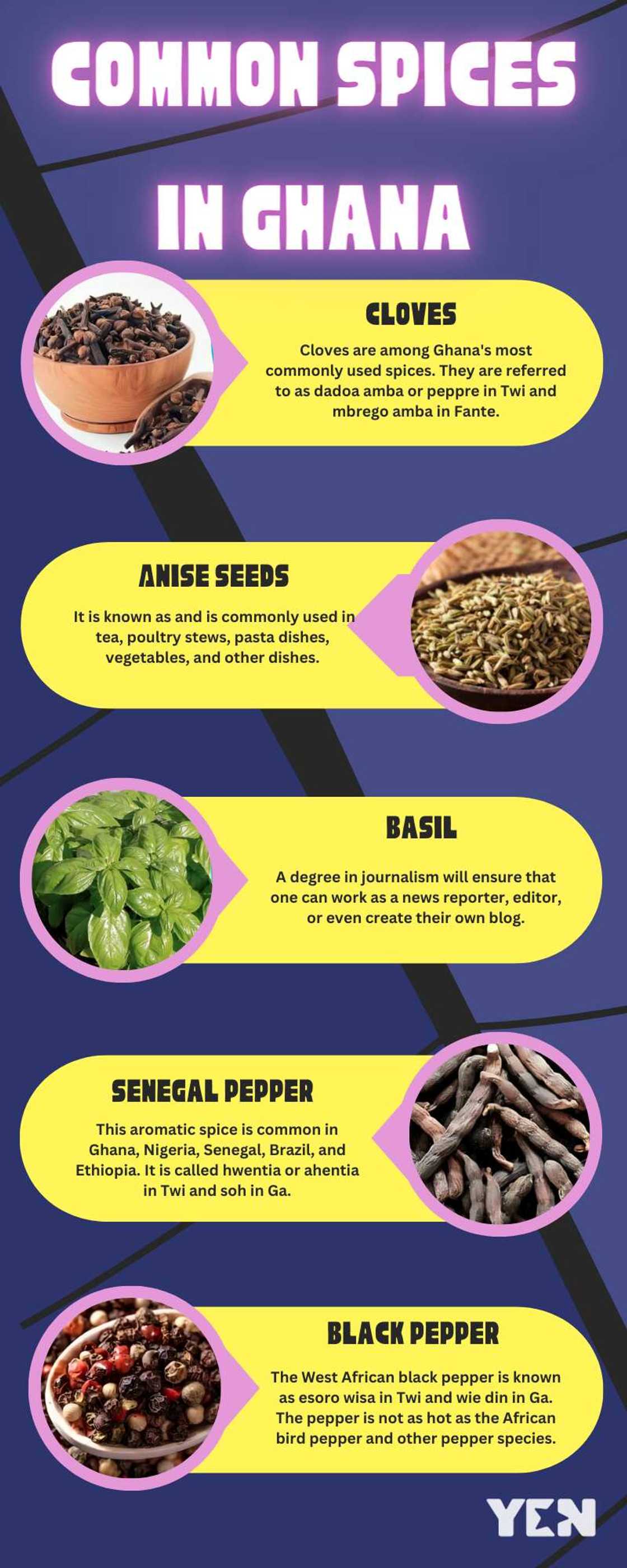
Source: Original
Yen.com.gh published a list of profitable business ideas in Ghana. If you aspire to start your own business someday, know which sectors are booming.
Researching trends in the country's business sector is essential, regardless of whether you have or do not have the money. First, discover an opportunity, examine it, and then look for capital.
Source: YEN.com.gh

Favour Adeaga (Lifestyle writer) Favour is an author, speaker, and coach. He graduated with a degree in Mass Communication from The Polytechnic, Ibadan, Nigeria, in 2011. He had his internship programme at The Nation Newspaper and taught diploma students in Newspaper and Magazine course at the Nasarawa State University, Keffi. He curates the facts and life hacks category since 2018. Favour is the author of two books available on Amazon. He currently lives in Nigeria. favouradeaga@gmail.com

Ann Steffie Ann Steffie is a content creator with 2+ years of working experience in the industry. She graduated from the Technical University of Kenya with a Bachelor’s Degree in Computer Science and Technology. She lives in Nairobi, Kenya and spends her free time pursuing her interests which include web development, artificial intelligence and machine learning. Email: madigoann@gmail.com










